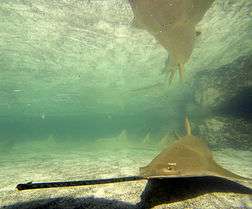Longcomb sawfish
| Longcomb sawfish | |
|---|---|
 | |
| Scientific classification | |
| Kingdom: | Animalia |
| Phylum: | Chordata |
| Class: | Chondrichthyes |
| Subclass: | Elasmobranchii |
| Order: | Pristiformes |
| Family: | Pristidae |
| Genus: | Pristis |
| Species: | P. zijsron |
| Binomial name | |
| Pristis zijsron Bleeker, 1851 | |
The longcomb sawfish or green sawfish (Pristis zijsron) is a sawfish of the family Pristidae, found in tropical waters of the Indo-West Pacific oceans, from the Red Sea and east Africa to Papua New Guinea, north to southern China, and south to New South Wales, Australia, between latitudes 21° N and 37° S. This critically endangered species can reach a length of up to 7.3 metres (24 ft).[2]
Description
The longcomb sawfish has a shark-like body and an elongated, blade-like snout known as a rostrum that has triangular, saw-like teeth on either side. This is the largest sawfish in the genus Pristis and can reach as much as 7.3 metres (24 ft) long with a rostrum measuring 1.66 metres (5 ft 5 in). The dorsal (upper) surface is greenish-brown, the dorsal fins are yellowish-grey and the flanks are yellowish fading to a creamy-white colour on the ventral (under) surface. The rostral teeth are greyish-yellow and the central part of the rostrum is a darker shade. These teeth are slender and sharply pointed and usually number 23 to 37 pairs and this enables the longcomb sawfish to be distinguished from the otherwise similar knifetooth sawfish (Anoxypristis cuspidata) which has fewer rostral teeth, triangular in shape and blunt.[3]
Distribution and habitat
The longcomb sawfish is native to the western Indo-Pacific. Its range extends from the east coast of Africa, the Gulf of Aden and the Red Sea to India, Malaysia, Thailand, Indonesia and northern Australia. It is also known from southern China, Vietnam, the Philippines and Papua New Guinea. It is found in shallow marine habitats down to a depth of about 5 metres (16 ft) on sandy and muddy seabeds. It frequents estuaries and can enter rivers, an individual having once been found 150 miles (240 km) inland in the Northern Territory of Australia.[3]
Biology
The longcomb sawfish thrashes its rostrum from side-to-side to dislodge prey from the seabed and to stun fish. It is believed to feed on crustaceans, fish and squid. Little is known of its breeding habits but they are probably similar to the better studied largetooth sawfish (Pristis microdon) which produces a litter of live young after a gestation period of about five months and which gives birth in alternate years. It is known that longcomb sawfish pups measure about 60 to 108 centimetres (24 to 43 in) at birth.[3]
Status
The longcomb sawfish is listed by the IUCN as "Critically Endangered" in its Red List of Threatened Species. The population is believed to have declined by 80% over three generations, with the main threat being fishing. It is not usually the target species but easily gets entangled in fishing nets, and is retained as bycatch for its meat, fins and rostrum.[1]
See also
References
- 1 2 Simpfendorfer, C. (2013). "Pristis zijsron". IUCN Red List of Threatened Species. Version 2013.1. International Union for Conservation of Nature. Retrieved 26 August 2013.
- ↑ Froese, Rainer and Pauly, Daniel, eds. (2006). "Pristis zijsron" in FishBase. May 2006 version.
- 1 2 3 "Green sawfish". Ichthyology. Florida Museum of Natural History. Retrieved 2013-09-24.

